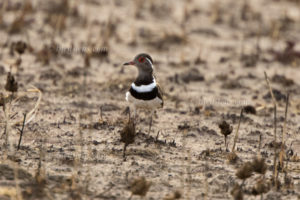 It is incredibly hot. If you would leave the air-conditioned bus, you will be attacked by extremely annoying bees. But: we are looking for the Forbes’s Plover (Charadrius forbesi).
It is incredibly hot. If you would leave the air-conditioned bus, you will be attacked by extremely annoying bees. But: we are looking for the Forbes’s Plover (Charadrius forbesi).
The Forbes’s Plover has to be found now. We drive to a flat area in the middle of the dry savannah of northern Ghana, which is probably flooded during the rainy season. As the guide explains, these places are not overgrown in the dry season. We are lucky. Just when we appear in the area we recognize a Forbes’s Plover. The excitement is great.
Two black breastbands and a red eyering are the key features of the Forbes’s Plover. On first sight it only slightly resembles a Three -banded Plover or Three-banded Sandplover (Charadrius tricollaris). The habit is definitely different. Additionally the Forbes’s Plover is larger, with darker upperparts; darker, browner head and a dark brown bill with red at base of lower mandible.
Our guides mention that we should take pictures from the bus. The Plovers would otherwise disappear. So everyone gets up and tears open the windows or pull them aside with force. With some it remains with the attempt. Since the windows overlap, an open window for one is a double-closed window for the other. So, after a while, all travelers have to see that they can shoot their photos from just a few windows. The Forbes’s Plovers, however, prove to be quite frugal. We see at least 4 specimens, although it is not clear whether they are pairs or individuals defending their territories. As sexes are alike, you do not see the gender. In any case, it is interesting that we had already visited the area the day before, and did not see a single Forbes’s Plover the day before. Suddenly other Forbes’s Plovers appear on the other side of the bus. Perfect position! And when our guide plays their calls and the Forbes’s Plover react, all tourists are more than satisfied. Our Local Guide even shoots photos with the phones of those who did come without a SLR camera. I am more than satisfied, too. In between I could even change cameras on the Canon EF 400mm 1: 4 DO IS II USM. Excellent! And all this without leaving the car and having to expose to the nasty bees.
At 3:15 p.m. the Bird Quest afternoon tour started. We drove at least three quarters of an hour from the Mole Motel on uneven tracks in the dry country bush. Finally we came to a largely open area, which was almost bare and was covered with only a few dry, not to say dried, shrubs.
The Forbes´s Plover is not really bound to water. It breeds in rocky highland habitats with granite outcrops, in Nigeria sometimes even on isolated mountain plateaus. During the dry season, the Forbes’s Plover can be seen in grassland habitats as well. Again, the bird shows a preference for open spaces; but sometimes near forests. Bare soil – like the one already described above – and recently burned areas are also welcome. But also muddy areas near lakes and rivers or reservoirs are visited.
To cope with the growing demand for top shots of the rarer species not only of the Western Palearctic, Bird-Lens is keen to enrich the range of pictures of birds you can find in the western Palearctic. Trips to remote places to capture images were very successful. The nice image of the blog is only a first impression, what you will find in the gallery in the “Picture Shop” very soon. Just give bird-lens.com a message, if bird-lens.com could serve you with an image needed before the new pictures are online.